Southern Paiute people
The Southern Paiute people /ˈpaɪjuːt/ are a tribe of Native Americans who have lived in the Colorado River basin of southern Nevada, northern Arizona, and southern Utah. Bands of Southern Paiute live in scattered locations throughout this territory and have been granted federal recognition on several reservations. Southern Paiute's traditionally spoke Colorado River Numic, which is now a critically endangered language of the Numic branch of the Uto-Aztecan language family, and is mutually intelligible with Ute.[1] The term Paiute comes from paa Ute meaning water Ute /ˈjuːt/, and refers to their preference for living near water sources.[2] Before European colonization they practiced springtime, floodplain farming with reservoirs and irrigation ditches for corn, squash, melons, gourds, sunflowers, beans and wheat.[2]
Nuwuvi | |
|---|---|
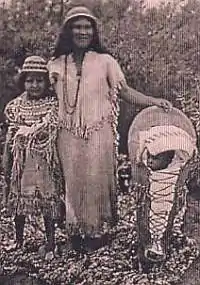 Moapa Woman and girl in traditional Paiute basket hats near Las Vegas circa 1900. Baby swaddled in rabbit robes in cradleboard. | |
| Regions with significant populations | |
( | |
| Languages | |
| Colorado River Numic (ISO 639-3, ute), English | |
| Religion | |
| Indigenous Religion, Christianity | |
| Related ethnic groups | |
| Utes, Kawaiisu |
The first European contact with the Southern Paiute occurred in 1776, when fathers Silvestre Vélez de Escalante and Francisco Atanasio Domínguez encountered them during an attempt to find an overland route to the missions of California. They noted that some of the Southern Paiute men "had thick beards and were thought to look more in appearance like Spanish men than native Americans".[lower-alpha 1] Before this date, the Southern Paiute suffered slave raids by the Navajo and the Ute. The arrival of Spanish and later Euro-American explorers into their territory increased slave raiding by other tribes. In 1851, Mormon settlers strategically occupied Paiute water sources, which created a dependency relationship. However, the presence of Mormon settlers soon ended the slave raids, and relations between the Paiutes and the Mormons were basically peaceful. The Mormon missionary Jacob Hamblin worked at diplomatic efforts. The introduction of European settlers and agricultural practices (most especially large herds of cattle) made it difficult for the Southern Paiute to continue their traditional lifestyle, as it drove away the game and reduced their ability to hunt, as well as to gather natural foods.

Today Southern Paiute communities are located at Las Vegas, Pahrump, and Moapa, in Nevada; Cedar City, Kanosh, Koosharem, Shivwits, and Indian Peaks, in Utah; at Kaibab and Willow Springs, in Arizona.
Public relations
Early policy
Prior to the 1850s the Paiute people lived relatively peacefully with the other Native American groups. These groups included the Navajo, Ute, and Hopi tribes.[6] Though there was the occasional tension and violent outbreaks between groups, Paiutes were mainly able to live in peace with other tribes and settlers due to their loose social structure. Most Paiutes lived in small familial groups, and only gathered together in large settings for matters of trade and commerce.[6] Prior to the 1850s, their biggest antagonists were raiders from competing tribes; such as the Navajos, Utes, and Hopis. The Navajos were particularly known for intruding on Paiute grazing land and engaging in raids to capture Paiute women and children for slave trade.[7]
Prior to the 1860s, there had been no long-term development of the land. Most of the non-native contact they had was with transient militants or traders. Paiutes fought hard to defend their ancestral lands, and at first were successful in driving the settlers out. During the second half of the 1800s, the most prominent groups to migrate to Paiute lands were members and missionaries from The Church of Jesus Christ of Latter Day Saints and silver miners in Pioche, Nevada.[8] In 1869, a rich investor named François Louis Alfred Pioche invested in a silver mine in the town of Pioche, which initially depended upon cheap Paiute labor to work in the mines. The conditions in the mines caused a dramatic decline in the Paiute population.[8] Paiute children were mandated to attend American schools, which attempted to assimilate them as much as possible.[9] By the early 1900s, there were approximately 800 Paiute people.[10]
Modern relations
In the 1950s, the Indian termination policies of the federal government stripped the Paiutes of their health and educational benefits, federal tax protection, and agricultural assistance. This left them on their own in a weak and unstable state.[11] The first attempt of reconciliation was made in 1980, with the Restoration Act, which recognized the Paiutes as a tribe. It united the five main bands into one tribe: the Cedars, Indian Peaks, Kanosh, Koosharem, and Shivwits.[12] The bill also restored the bands to a system of federal aid and support.
Culture
Basket weaving
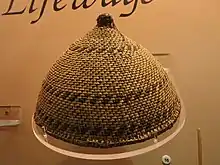
One of the most important skills the women of the Paiute tribes had was their basket weaving skills. They would often use red-stemmed willows to weave their baskets. These skills were used in almost every aspect of their lives, and the skill is believed to have been passed down from mother to daughter for at least 9,000 years. When they would go to gather and forage they would carry large conical baskets on their back to collect things.
Specific tools were created including ones to strip fruit off of bushes and trees, ones used for winnowing, and ones used to get to roots better. They would also tightly weave these big baskets with clay and resin to create cooking pots and water jugs. Oftentimes, smaller tools were left behind, whereas bigger products such as cooking pots went with the families as they moved around. Based on the region the families were located determined different uses for the weaving. For instance, those who lived by marshes learned to create duck decoys, nets, and rafts to better hunt the water fowl. Another use for this skill was to create their houses. They would use long thin grasses to tightly weave stalks of Cattails together, and in doing so they created these long board-like sections of grasses that they would set up around long willow limbs stuck in the ground.[13]
Traditional diet
A staple food for the Southern Paiutes was the bitterroot. They also depended on wild carrot, wild onion, and chokecherries. Chokecherries were useful in more ways than one - their stems were brewed to make a sweet drink, and their berries would be crushed, then dried to be saved for later. When Aphids came and swarmed the cane plants, they would leave small drops of nectar where they punctured the cane stalk. Knowing this the Southern Paiute women would take the cane rods and beat them until the small dried droplets came loose. These droplets were then tossed in a winnowing dish to be separated from the remnants of the cane. Often these small particles were the main income of sweetness for the people.[13] Another seed they would gather are waada seeds, minuscule black seeds that would be ground up into meal.[14] Those who lived in a region with an adequate water supply would set up farms, complete with ditch irrigation. The biggest crops were maize, squash and wheat.[15] The men were the primary hunters, they would hunt waterfowl, rabbits, bighorn sheep and other mammals in the regions they passed through.[14]
Bows
There is a bow collected by the Smithsonian Institution in 1872.[16] Made from a hardwood branch, possibly Mesquite or mountain mahogany, and is 38 5/8 inches from tip to tip. The bow is round in cross section, and the string is two ply sinew. It has a sinew back, and the sinew has been stained with a reddish brown ochre. The bow is utilitarian and still has carving marks, as to be expected of a practical weapon in a hostile and harsh desert environment.[17] Another photograph is taken of a Paiute bow and arrow.[18]
Arrows
A set of Paiute arrows was acquired by the Smithsonian Institution in 1874.[19] Only one arrow has a point. The arrowhead is attached by pine pitch glue. There are sinew wrappings behind the point, but they are to prevent the shaft from splitting when the target is hit. The feathers are hawk and buzzard.[17]
Quivers and bowcases
A Paiute arrow quiver was acquired by the Smithsonian Institution in 1872.[20] The quiver is made of deerskin with thick hair still on the case, showing the deer was killed in the winter, and is sewn with two ply sinew, much like the bowstring. "The quiver is plain, with no decoration, as would be expected of a desert dwelling culture."[17]
Holy land traditions
The Southern Paiute people believe in Puaxant Tuvip, or power land. It is their holy land that links to many significant landmarks in the Southern Paiutes memory and stories. For instance Nuvagantu, or Mt. Charleston in Nevada is a holy landmark that the Southern Paiute people believe was where they were created. These holy lands were places that the separate families or tribes would come to barter, trade, socialize and perform religious ceremonies. Another large landmark that is culturally significant to the Southern Paiutes is the Colorado river and the Grand Canyon. The modern-day importance of these Holy Lands is that the Southern Paiutes claim the supernaturally given right to know what happens and the impacts of any projects that occur in their holy lands.[21]
Organization of the Southern Paiute people
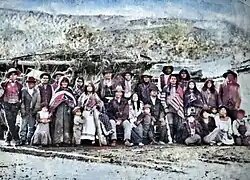
One important aspect of gathering food was the social aspect, often families would come together for foraging and games and then depart and go their different ways. The Southern Paiutes were not organized tribally. Groups were instead made up of small family units that would occasionally come together with others to socialize. Each group was about 10-50 related people. Family ties were very important to these groups and determined group movements and interdependence among groups. Marriages were thus very important to the Southern Paiutes.
The leader of the group was called a Headman, and he would be old enough to know a lot about the land, but young enough to still participate in the tribes activities, and he usually had several different family ties within the group. His job was to wake early in the morning, and using his knowledge he would make specific suggestions of what he thought the tribe should do that day, and if people thought his observations were astute they would follow him, if not then they wouldn't. His suggestions would be based on the weather, season, and abundance of food. If over time they stopped following his ideas and instead turned to another, then the Headman leader title would move onto that person. The Headman also was supposed to settle any disputes that came up.[22] Oftentimes different sub-units of the Southern Paiutes would be classified by the settlers coming in from Europe based on what they ate. So you had those who ate waada seeds, those who ate trout, those who ate cattails, etc.[13] While the Southern Paiute people are categorized as one group, there were subgroups within the whole that were differentiated based on location and dialect.[23]
Traditional Southern Paiute bands
The Southern Paiute traditionally had 16 to 31 subgroups, bands, or tribes,[24] including the following:
- Ankakkani'kacimi (Un-ka-ka'-ni-guts, Unka-kanig-its, Oaw'tuhus'eng):
- "Yellow Mouth of Canyon People" in present Long Valley
- Antarianunts (Ute name with ending unts, Paiute name Yantarɨi):
- Mixed Southern Paiute-Ute band from Escalante River east to Colorado River and southeast to Henry Mountains, Utah[24]
- Beaver band (Kʷi?umpacíɨi, Kwiumpus, Quiumputs)):
- "Frasera speciosa people", lived in Beaver Valley along Beaver River near today's Beaver, Utah,[24] some intermarried with the Pahvant Ute band to the north living in the deserts near Sevier Lake
- Cedar band (Ankappanukkicɨcimɨ, Unkapanukuints):
- "Red-stream people", or Suh’dutsing, "Cedar people" from near Cedar City, Utah[24]
- Chemehuevi /tʃɛmɪˈweɪvi/ (Nüwüwü, Tantáwats):
- Gunlock band (Matooshats, Matissatï):
- Name given them by their southern neighbors, the St. George band/Uainuints, Gunlocks instead bestowed the term to some Southern Paiute bands northeast of them. Lived near Gunlock[31] in southwest Utah
- Kaibab (Kai'vi'vits, Kaipapicɨcimɨ, Kaivavwits, Kaibabits, Kaipa'pici, Kaivavituvingui):
- "Mountain Lying Down People" the Kaibab Plateau and Kaibab National Forest in northern Arizona are named after them[31]
- Indian Peak Band (Kwee’choovunt):
- "Peak People"
- Kaiparowits:
- "Mountain home of the people", lived along the Escalante River and were hunting the Kaiparowits Plateau in Utah,[31] therefore also known as Escalante band
- Las Vegas band (Nɨpakantɨcimɨ, Nuvagantucimi):
- "People of Charleston Peak"[31]
- Moapa (Muapaa, Moapats):
- Pahranagat (Pata?nikicɨ):
- "Person who sticks his feet in the water", named for the Pahranagat Valley, Nevada[31]
- Panaca (Tsouwaraits, Matisabits):
- Named for Panaca, Nevada[33]
- Panguitch (Pakiucimi):
- "Fish people", named for Panguitch, Utah[33]
- San Juan band (Kwaiantikowkets):
- "People being over on the opposite side", from the San Juan River in northern Arizona[33]
- Shivwits (Sipicimi, Shebits, Sübüts):
- "People who live in the East"[33] or See’veetseng, "Whitish Earth People"
- Uinkaret (Yipinkatɨtɨcimɨ):
- "People of Mount Trumbull"[33]
- Uainuints (Uenuwunts, Tonaquints):
- Hunted and farmed from Hebron (Shoal Creek Fort), Enterprise and Pinto southward along the Santa Clara River (also called Tonaquint River) to his mouth into the Virgin River south of today's Saint George, Utah, therefore called St. George Band)[33]
Contemporary Southern Paiute federally recognized tribes
- Kaibab Band of Paiute Indians of the Kaibab Indian Reservation, Arizona—Kaibab Indian Reservation, Kaibab, Arizona
- Las Vegas Tribe of Paiute Indians of the Las Vegas Indian Colony—Las Vegas, Nevada
- Moapa Band of Paiute Indians of the Moapa River Indian Reservation—Moapa River Indian Reservation, Moapa, Nevada
- Paiute Indian Tribe of Utah—Cedar City, Utah
- San Juan Southern Paiute Tribe of Arizona—Navajo Nation, Tuba City, Arizona
Notable Southern Paiutes
- Tau-gu (1845?–1895?): Leader in the 1870s
- Tony Tillohash (1886–1972): Linguist and politician
Gallery of traditional dress, hairstyles, buildings, and basket making
.jpg.webp) Young men in Reno, Nevada, circa 1870
Young men in Reno, Nevada, circa 1870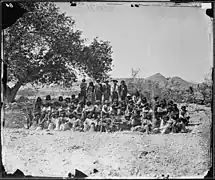 Paiute group Cottonwood Spring, Nevada, 1871
Paiute group Cottonwood Spring, Nevada, 1871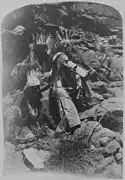 Traditional dress and hunting bow, 1872
Traditional dress and hunting bow, 1872.jpg.webp) Basket weaver photographed circa 1873
Basket weaver photographed circa 1873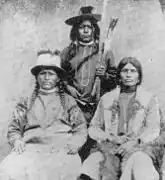 Paiutes near Mountain Meadows, southwestern Utah 1880
Paiutes near Mountain Meadows, southwestern Utah 1880_(20238401718).jpg.webp) Chipping a stone knife, 1901
Chipping a stone knife, 1901 Basket maker, 1902
Basket maker, 1902_resting_outside_of_mud_and_grass_hut_LCCN2006679025.jpg.webp) Homes circa 1906
Homes circa 1906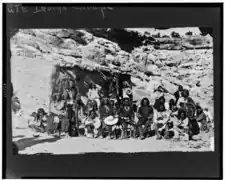 Adobe house 1909
Adobe house 1909
Notes
- Warner (1995, pp. 187–193) cites Dominguez & de Escalante (1776)
References
- "Peoples of Mesa Verde: The Ute–Southern Paiute Connection". Crow Canyon Archaeological Center. 2014. Retrieved May 3, 2023.
- "About The Southern Paiute". National Park Service. Retrieved May 3, 2023.
- Stoffle, Richard W.; Loendorf, Lawrence; Austin, Diane E.; Halmo, David B.; Bulletts, Angelita (February 2000). "Ghost Dancing the Grand Canyon: Southern Paiute Rock Art, Ceremony, and Cultural Landscapes". Current Anthropology. Chicago: University of Chicago Press. 41 (1): 12. doi:10.1086/300101. PMID 10593723. S2CID 142526911. Retrieved May 4, 2023 – via ResearchGate.
- Richard, Arnold; Spoon, Jeremy. "Nuwuvi (Southern Paiute) Ancestral Territory". International Union for Conservation of Nature. Retrieved May 4, 2023.
- "Nuwuvi (Southern Paiute)". Native Land Digital. August 7, 2022. Retrieved May 4, 2023.
- Holt, Ronald L. (April 22, 2016). "Paiute Indians". Utah State Department of Community & Cultural Engagement.
- Bunte, Pamela; Franklin, Robert (1992). "You Can't Get There from Here: Southern Paiute Testimony as Intercultural Communication". Anthropological Linguistics. 34 (1/4): 19–44. JSTOR 30028366.
- Reeve, W. Paul (2006). "Mormons, Miners, and Southern Paiutes". Making Space on the Western Frontier. University of Illinois Press. ISBN 9780252031267. JSTOR 10.5406/j.ctt1xcnr6.
- Riggs, Christopher K. (2000). "American Indians, Economic Development, and Self-Determination in the 1960s". Pacific Historical Review. 69 (3): 431–463. doi:10.2307/3641716. JSTOR 3641716.
- Indian Tribe of Utah: History Utahpaiutes.org. Retrieved 7 January 2019.
- Holt, Ronald L. “Paiute Indians.” Utah Department of Heritage and Arts, 17 Aug. 2016, heritage.utah.gov/history/uhg-first-peoples-paiute-indians.
- "Our History – the Paiute Indian Tribe of Utah".
- Patapoff, E. (Director) (1979). The Earth is Our Home. Retrieved October 12, 2018 – via Kanopy.
- Cultural Resources Management program (2012). "Rock Art of the Malheur Marshlands The Wada'Tika: Ancestors of Today's Burns Paiute Tribe, Oregon". US Fish and Wildlife Service. Retrieved November 12, 2018.
- Allison, James R.; Meegan, Cathryn M.; Murray, Shawn Sabrina (2008). "Archaeology and Archaeobotany of Southern Paiute Horticulture in the St. George Basin, Southwestern Utah". KIVA: Journal of Southwestern Anthropology and History. Arizona Archaeological and Historical Society. 73 (4): 417–449. doi:10.1179/kiv.2008.73.4.003. JSTOR 30246559. S2CID 129614910 – via Taylor & Francis.
- Smithsonian Institution, Department of Anthropology, Catalogue Number E-12034-0.
- Berger, Billy. 2010. "Treasures of the Smithsonian. Part V. Archery of the Southwestern United States: Paiute. " Primitive Archer. Volume 18 (5). October–November 2010. Pages 2025.
- Photograph of Willard George Shooting a Bow and Arrow (Neb.), 1899–1900. University of Nevada, Las Vegas University Libraries, n.d. Notes: Taken in Nebraska, Willard George (left) is showing a relative how to shoot a Paiute bow and arrow.
- Smithsonian Institution, Department of Anthropology, Catalogue number E-14539.
- Smithsonian Institution, Department of Anthropology, Catalogue Number E-12038-0.
- Stoffle, Richard W.; Halmo, David B.; Austin, Diane E. (1997). "Cultural Landscapes and Traditional Cultural Properties: A Southern Paiute View of the Grand Canyon and Colorado River". American Indian Quarterly. 21 (2): 229. doi:10.2307/1185646. ISSN 0095-182X. JSTOR 1185646 – via ResearchGate.
- Knack, Martha C. (2004). Boundaries between : the Southern Paiutes, 1775-1995. University of Nebraska Press. pp. 20–25. ISBN 9780803278189 – via Google Books.
- Steward, Julian (1933). University of California Publications in American Archaeology and Ethnology. Berkeley, California: University of California Press. pp. 233–250.
- Kelly & Fowler 1986, p. 394.
- Trafzer, Clifford E. (August 1, 2015). A Chemehuevi Song: The Resilience of a Southern Paiute Tribe. Seattle, Washington: University of Washington Press (published June 2015). pp. 17–18. ISBN 978-0-295-80582-5 – via Google Books.
- Ocampo, Daisy (June 13, 2023). Where We Belong: Chemehuevi and Caxcan Preservation of Sacred Mountains. Tucson, Arizona: University of Arizona Press. p. 56. ISBN 978-0-8165-4868-2 – via Google Books.
{{cite book}}: CS1 maint: date and year (link) - "Chemehuevi Indian Tribe". Southern California Tribal Chairmen's Association. Retrieved May 4, 2023.
- Knack, Martha C. (November 1, 2004). Boundaries Between: The Southern Paiutes, 1775-1995. University of Nebraska Press. p. 96. ISBN 978-0-8032-7818-9 – via Google Books.
- Nuwuvi: A Southern Paiute History. Inter-Tribal Council of Nevada. 1976. p. 10 – via University of Utah.
{{cite book}}: CS1 maint: date and year (link) - Lefler, Brian (January 1, 2000). Nuwuvi (Southern Paiute) Ecological Knowledge of Piñon-Juniper Woodlands: Implications for Conservation and Sustainable Resource Use in Two Southern Nevada Protected Areas (Master of Anthropology thesis). Portland State University. p. 10. doi:10.15760/etd.2006. S2CID 126665057.
- Kelly & Fowler 1986, p. 395.
- Yanawant Paiute Places and Landscapes in the Arizona Strip: Volume Two Of The Arizona Strip Landscapes and Place Name Study, Part 2, Page 63 Link
- Kelly & Fowler 1986, p. 396.
Sources
- Dominguez, Atanasio; Vélez de Escalante, Silvestre (1776). Derrotero de los Padres Fray Francisco Atanacio Domínguez, and Fr. Silvestre Vélez, de Escalante, en sus exploraciónes, desde las missiones de Zuñy del Nuevo Mexico, hasta las ymmediaciones de Monte Rey de California.
- Hogan, C. Michael (2008). Burnham, A. (ed.). "Morro Creek – Ancient Village or Settlement in United States in The West". The Megalith Portal. Archived from the original on May 24, 2013.
- Kelly, Isabel T.; Fowler, Catherine S. (1986). "Southern Paiute". In d'Azevedo, Warren L. (ed.). Handbook of North American Indians. Vol. 11 Great Basin. William C. Sturtevant, general editor. Smithsonian Institution. pp. 368–397. ISBN 978-0-16-004581-3.
- Kroeber, Alfred L. (1925). Handbook of the Indians of California. Bulletin (Smithsonian Institution. Bureau of American Ethnology). Vol. 78. Washington, D. C.: Government Printing Office.
- Pritzker, Barry M. (2000). "Paiute, Southern". A Native American Encyclopedia: History, Culture, and Peoples. OUP. ISBN 978-0-19-513877-1.
- Warner, Ted J., ed. (1995). The Domínguez–Escalante journal : their expedition through Colorado, Utah, Arizona, and New Mexico in 1776. Translated by Chávez, Angélico. foreword by Robert Himmerich y Valencia. University of Utah Press. ISBN 978-0-87480-447-8.
Further reading
- Dutton, Bertha Pauline (1976). The Ranchería, Ute, and Southern Paiute Peoples (2nd ed.). Prentice-Hall. ISBN 978-0-13-752923-0.
External links
Tribes
Language
- Southern Paiute Collection of Charles Cairns at AILLA – contains audio recordings of words, phrases, and a story in the Southern Paiute language.
